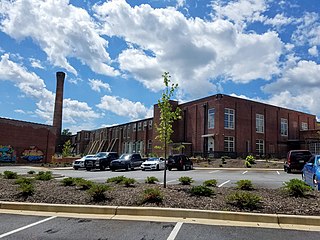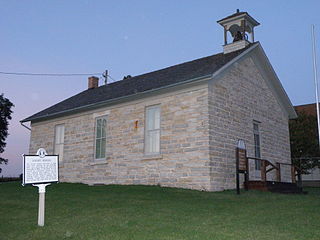
Spartanburg County is a county located on the northwestern border of the U.S. state of South Carolina. As of the 2020 census, the population was 327,997, making it the fifth-most populous county in South Carolina. Its county seat is Spartanburg.

Gaffney is a city in and the seat of Cherokee County, South Carolina, United States, in the Upstate region of South Carolina. Gaffney is known as the "Peach Capital of South Carolina". The population was 12,539 at the 2010 census, with an estimated population of 12,609 in 2019. It is the principal city of the Gaffney, South Carolina, Micropolitan Statistical Area, which includes all of Cherokee County and which is further included in the greater Greenville-Spartanburg-Anderson, South Carolina Combined Statistical Area.

Pickens, formerly called Pickens Courthouse, is a city in Pickens County, South Carolina, United States. The population was 3,126 at the 2010 census. Pickens changed its classification from a town to a city in 1998, but it was not reported to the Census Bureau until 2001. It is the county seat of Pickens County. It was named after Andrew Pickens (1739–1817), an American revolutionary soldier and US Congressman for South Carolina.

Converse University is a private university in Spartanburg, South Carolina. It was established in 1889 by a group of Spartanburg residents and named after textile pioneer Dexter Edgar Converse. It was originally a women's college but now admits men and women to its undergraduate college and its graduate, online, and summer programs.
Moore is an unincorporated community in Spartanburg County in the U.S. state of South Carolina.

Pine Street Elementary School is a public elementary school located at 500 South Pine Street in Spartanburg, South Carolina. It serves children from kindergarten through fifth grade and is part of Spartanburg County School District No. 7. Its school building, constructed in 1928–29, is a prominent local example of Beaux Arts architecture, and was listed on the National Register of Historic Places in 2016. It is the oldest continuously operating school in Spartanburg County.

Walnut Grove Plantation, the home of Charles and Mary Moore, was built in 1765 on a land grant given by King George III. The property is located in Roebuck in Spartanburg, South Carolina. Charles Moore was a school teacher and used the 3,000-acre (12 km2) plantation as a farm. The Moores had ten children, and some of their descendants still live within the area.

This is a list of the National Register of Historic Places listings in Spartanburg County, South Carolina.

Episcopal Church of the Advent is a historic Episcopal church at 141 Advent Street in Spartanburg, South Carolina.

The Eagle Harbor Schoolhouse is a school located at the corner of Third and Center Streets in Eagle Harbor, Michigan, United States. It is significant as the location where Justus H. Rathbone was first inspired to write the ritual which was the basis of the Order of the Knights of Pythias. The schoolhouse was designated a Michigan State Historic Site in 1971 and listed on the National Register of Historic Places in 1972. It is also known as the Pythian Shrine and as the Rathbone School.
Woodruff High School is a public secondary school in Woodruff, South Carolina, United States, and is the only high school in Spartanburg County School District 4.

Arcadia Mills No. 2, now the Mayfair Lofts, is a historic mill building at 100 W. Cleveland St., Spartanburg, South Carolina. It was listed on the National Register of Historic Places in 2005.

Monaghan Mill, now the Lofts of Greenville, is a former textile mill (1900–2001) in Greenville, South Carolina, that in the early 21st century was converted into loft apartments. The building is listed on the National Register of Historic Places.

Fremont School, also known as Freemont School, is a historic elementary school building located in Spartanburg, Spartanburg County, South Carolina. It was built in 1915, and is a two-story, brick Classical Revival style building with a partially raised basement, and a major addition built in 1926. It features decorative brickwork, terra cotta ornamentation, and entrance porticoes. The building housed an elementary school from 1915 to 1979.

Old Woodruff High School is a historic high school building located at Woodruff, Spartanburg County, South Carolina. It was built in 1925, and is a two-story, modified "H" plan stuccoed masonry building in the Collegiate Gothic style. It consists of a three-part center section with two perpendicular wings. The building has a flat roof with parapet, Gothic arches, recessed entrances framed by pointed arches. The building housed a high school until 1953 when Woodruff High School was constructed, then used as a middle school and later an elementary school. In 1978 the City of Woodruff acquired old Woodruff High School and adapted it for use as its city hall and police headquarters.

Drayton Mill is a historic textile mill complex located near Spartanburg, Spartanburg County, South Carolina. The complex includes the distinctive Tudor Revival company store and office building, constructed in 1919. Other buildings and structures include the three-story, rectangular, red brick spinning mill (1902-1904) with later additions, a cotton warehouse (1918), a two-story weaving building (1928), a 1,500,000 gallon mill pond, two water towers, two pump buildings, and an information center.

Arcadia Mills No. 1, now the Arcadia Station Lofts, is a historic mill building at 1875 Hayne Street in Spartanburg, South Carolina. The mill was built in 1903 and enlarged in 1909, to designs by Greenville J.E. Sirrine. It is a well-preserved example of textile mill engineering from the early years of South Carolina's boom period in that industry.

Locust School is a historic building located north of Decorah, Iowa, United States. Built in 1854, the one-room schoolhouse is composed of rubble ashlar limestone and capped with a gable roof. The lintels and window sills are also stone. A belfry with round-arch openings is located above the main entrance. The school was established just after the village of Locust was surveyed and settlement had begun. It remained in operation with all elementary grades until 1950, when it was reduced to specific grades. It was closed in 1960. The Winneshiek County Historical Society acquired the building and operates a museum in it. It was one of the first school buildings constructed in Winneshiek County. The building was listed on the National Register of Historic Places in 1978.

The Apalache Mill, now the Lofts by the Lake, is a historic textile mill at 2200 Racing Road in Apalache, South Carolina. The main mill building, a three-story brick building with plain late-19th century styling, sits at the southern end of Apalachee Lake, created by damming the Tyger River at a narrow gorge just to the east. Built in 1888, it is one of the first mills to be built in the Spartanburg area, and remained in active service until 2007.

A two-room schoolhouse is a larger version of the one-room schoolhouse, with many of the same characteristics, providing the facility for primary and secondary education in a small community or rural area. While providing the same function as a contemporary primary school or secondary school building, a small multi-room school house is more similar to a one-room schoolhouse, both being architecturally very simple structures. While once very common in rural areas of many countries, one and two-room schools have largely been replaced although some are still operating. Having a second classroom allowed for two teachers to operate at the school, serving a larger number of schoolchildren and/or more grade levels. Architecturally, they could be slightly more complex, but were still usually very simple. In some areas, a two-room school indicated the village or town was more prosperous.





















